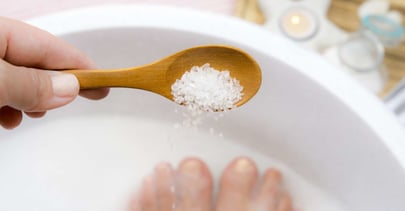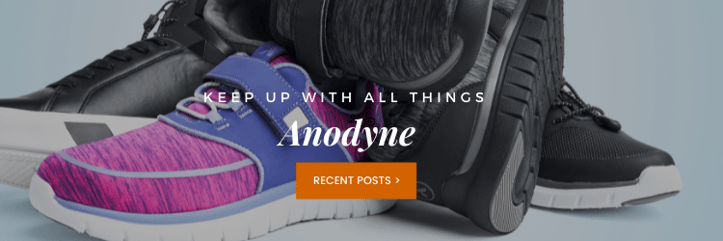Sore feet, swelling, inflammation and related foot complications can be a product of various sources. Experiencing any of these symptoms? Schedule an appointment with a podiatrist or primary care physician for proper diagnosis and treatment. One of the more common diagnoses for foot swelling and discomfort is a condition known as peripheral edema.
.jpg?width=750&height=422&name=Anodyne%20Blog%20Template%20(2).jpg)
Edema is most commonly characterized by a swelling in one’s feet and ankles. Many factors can lead to edema, including high blood pressure, pregnancy, and excessive standing. However, what’s the root cause of this issue?
Uncomfortable swelling isn't necessarily a full-blown disorder. Often, it's an early sign of an underlying issue. Whether it's new or recurring, see your doctor to find the root cause.
That uncomfortable swelling is not actually a disorder. In most cases, it’s a preliminary symptom that requires some proactive treatment.
In the meantime, some at-home steps can help manage the swelling. We'll explore these tips next!
Magnesium Supplement
A magnesium deficiency in the body is one of the many possible causes of edema. Using a supplement (generally available over the counter) can help provide some relief. Experts generally recommend taking magnesium supplements at around 200mg, twice a day. If you're considering this supplement, please consult your primary care provider first for dosing recommendations.
Yoga
Looking for ways to improve circulation in your feet? Exercise is a great option!
Yoga, in particular, can be a fantastic choice. It gets your whole body moving, including your feet, muscles, and bones. This helps promote healthy blood flow throughout your body.
Plus, yoga can target specific areas of tension and pain, like your feet and ankles, when done correctly. Before starting yoga, especially if you're new to it, talk to your doctor. They can advise you on whether it's safe for you.
Related: 5 Seated Yoga Poses You Can Do at Your Desk
Tonic Water Soaks
Here's an unusual but effective tip: a cool foot soak with tonic water! Fill a container with lukewarm or room temperature tonic water, find a comfy spot to sit, and soak your swollen feet for 10-15 minutes. This might help reduce swelling and ease any discomfort you're feeling.
Salt Water Soaks
Don't have tonic water? No sweat! Plain water with a little salt or Epsom salt works just as well.
- For swollen feet and ankles, soak them in a warm bucket with Epsom salts.
- If your calves are swollen too, a full bath might be more comfortable.

Epsom salts are a popular choice for reducing swelling. Many of our Anodyne employees swear by Epsom salt baths after long runs to relax their muscles and ease aches and pains.
Leg and Foot Massage
A massage therapist can help! Massage can ease discomfort and improve circulation in your feet and legs. Be sure to tell your therapist about the specific pain and swelling you're experiencing so they can focus on those areas.
/blog_images/foot_inspection.jpg?width=320&height=979&name=foot_inspection.jpg)
Support Hosiery and Compression Socks
Support socks or compression stockings can help prevent swelling throughout the day. They gently squeeze your legs, keeping fluids from building up and causing puffiness.
Depending on your needs, you can choose from knee-high, thigh-high, or full-length compression socks.
Elevate Your Feet
The constant pull of gravity can take its toll! Here are some simple ways to elevate your feet and improve circulation:
- Quick Rest: Throughout the day, prop your feet up on an ottoman or a chair for a few minutes. This can offer immediate relief.
- Evening Relaxation: When you're winding down, prop your legs up on pillows. Ideally, position your feet above your heart.
- Ultimate Comfort: If you can, lie down and elevate your legs straight up a wall for several minutes. This maximizes circulation throughout your body and lower legs.
Taking a break with your feet up can seriously reduce swelling and discomfort. You'll feel refreshed and ready to conquer anything!
If you work a day job, try to find a way to prop your feet up under your desk. Even elevating a bit can make a big difference in your swelling.
Swimming
Swimming or simply floating in water can be a great way to combat swollen feet and ankles. The water's gentle pressure helps blood flow better in your legs, and floating lets your circulation relax without constantly working against gravity. So next time your feet feel puffy, consider a refreshing dip in the pool!
Drink Up!
Salty foods can make swelling worse, but drinking plenty of water helps flush it out. Aim for 8-10 glasses of water a day to keep your system balanced.
For an extra boost, try cucumber-lemon water! Just add a few slices to your glass for a refreshing and anti-inflammatory drink.
The 9 natural remedies we listed above can help you manage swelling and discomfort in your feet and ankles. They can also be helpful for preventing future problems.
It's important to wear shoes that fit well and provide good support, especially if you experience swelling. Look for shoes specifically designed for people with diabetes (diabetic shoes) as they often have features that accommodate some swelling. This allows you to wear comfortable, well-fitting shoes even when your feet and ankles are a bit puffy.



.png?width=116&name=Anodyne_circle_1_logo%20(2).png)
